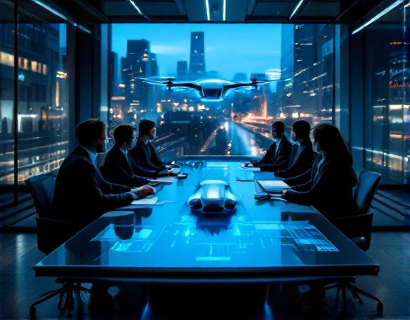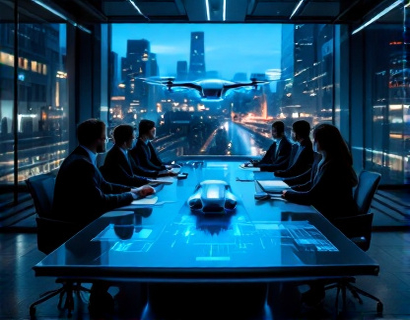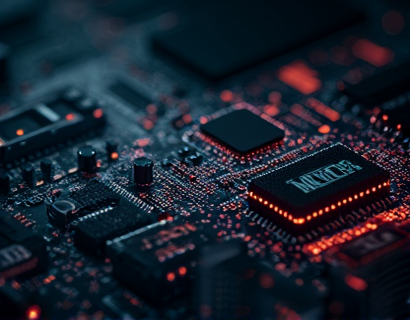AI-Powered Aeronautics: Leveraging Intelligent Agents for Industry Transformation
The aeronautics industry, a cornerstone of global transportation and commerce, is undergoing a profound transformation driven by the integration of artificial intelligence (AI). Intelligent agents, powered by advanced AI algorithms, are revolutionizing various aspects of the sector, from operational efficiency to strategic decision-making. This article delves into the transformative impact of AI agents in aeronautics, exploring how these technologies are optimizing operations, enhancing decision-making, and driving innovation. For industry professionals and businesses seeking to leverage AI for sustainable growth and a competitive edge, understanding these advancements is crucial.
Optimizing Operations with AI Agents
One of the most significant areas where AI agents are making a difference is in operational optimization. Traditional aeronautics operations involve complex logistics, maintenance schedules, and resource allocation, which can be prone to inefficiencies and human errors. AI agents streamline these processes by analyzing vast amounts of data in real-time, identifying patterns, and making predictive adjustments. For instance, AI can optimize flight paths to reduce fuel consumption and travel time, taking into account weather conditions, air traffic, and aircraft performance metrics. This not only lowers operational costs but also minimizes environmental impact.
Maintenance is another critical area where AI agents excel. Predictive maintenance, powered by machine learning, allows for the proactive identification of potential equipment failures before they occur. By analyzing sensor data from aircraft components, AI agents can predict when a part is likely to fail and schedule maintenance accordingly. This approach reduces downtime, extends the lifespan of equipment, and ensures higher safety standards. For airlines and manufacturers, this means more reliable operations and significant cost savings.
Enhancing Decision-Making with Data-Driven Insights
Decision-making in the aeronautics industry is often complex and multifaceted, involving a wide range of stakeholders and data sources. AI agents provide a robust platform for data-driven decision-making by offering actionable insights derived from comprehensive data analysis. These insights can range from market trends and customer behavior to supply chain dynamics and regulatory changes. By leveraging AI, businesses can make informed decisions quickly, adapting to the dynamic market conditions with greater agility.
For example, AI can analyze historical flight data to identify patterns that affect passenger satisfaction and operational efficiency. This information can guide decisions on fleet management, route optimization, and service enhancements. Additionally, AI agents can simulate various scenarios to forecast the impact of different strategic choices, enabling businesses to choose the most viable options. This level of insight not only improves operational outcomes but also enhances customer experience and loyalty.
Driving Innovation through AI-Powered Solutions
The integration of AI in aeronautics is not just about optimizing existing processes; it is also a catalyst for innovation. AI-powered solutions are enabling the development of new technologies and services that were previously unimaginable. One notable area is the design and manufacturing of aircraft. AI algorithms can optimize the design process by simulating thousands of variations to find the most efficient and durable configurations. This leads to lighter, more fuel-efficient aircraft, reducing operational costs and environmental impact.
Another innovative application is in the realm of autonomous systems. AI agents are at the forefront of developing unmanned aerial vehicles (UAVs) and autonomous ground vehicles for various aeronautics applications, from surveillance and inspection to cargo transport. These systems can operate in challenging environments, reducing the need for human intervention and enhancing safety. The potential for autonomous drones in delivery services, for instance, is transforming last-mile logistics, making it faster and more cost-effective.
Case Studies: Real-World Applications of AI in Aeronautics
To better understand the practical benefits of AI in aeronautics, let's look at a few real-world case studies. A major airline implemented an AI-driven predictive maintenance system, resulting in a 20% reduction in maintenance costs and a 15% decrease in unscheduled downtime. Another example is a manufacturing company that used AI to optimize its supply chain, achieving a 10% reduction in lead times and a 5% decrease in inventory costs. These successes underscore the tangible benefits of AI integration in the industry.
Challenges and Considerations
While the benefits of AI in aeronautics are clear, there are also challenges and considerations that businesses must address. One primary concern is data security and privacy. The vast amounts of data required for AI systems must be handled with stringent security measures to protect sensitive information. Additionally, the complexity of AI algorithms can make it difficult to interpret and trust the decisions made by these systems. Ensuring transparency and explainability in AI decision-making is crucial for gaining stakeholder confidence.
Another consideration is the need for skilled professionals who can develop, implement, and maintain AI solutions. The aeronautics industry must invest in training and development programs to build a workforce capable of leveraging these advanced technologies. Collaboration between industry players, academic institutions, and technology providers is essential to address these challenges and foster a culture of innovation.
Future Trends and Opportunities
Looking ahead, the integration of AI in aeronautics is poised to bring even more transformative changes. One emerging trend is the use of AI in air traffic management. Intelligent agents can optimize airspace usage, reduce congestion, and improve flight scheduling, leading to more efficient and safer air travel. Another area of growth is in the development of smart airports, where AI technologies enhance passenger experiences through personalized services, streamlined check-in processes, and real-time information updates.
Furthermore, the convergence of AI with other cutting-edge technologies, such as the Internet of Things (IoT) and blockchain, opens up new possibilities. IoT devices can provide real-time data for AI systems to analyze, while blockchain can ensure secure and transparent data transactions. These synergies will drive further innovation and efficiency in the aeronautics sector.
Conclusion
The integration of AI-powered agents in the aeronautics industry is not just a trend but a necessity for staying competitive in a rapidly evolving market. By optimizing operations, enhancing decision-making, and driving innovation, AI agents offer significant benefits that can lead to sustainable growth and a competitive advantage. For industry professionals and businesses, embracing these technologies is essential for navigating the future of aeronautics. As the industry continues to evolve, those who leverage AI effectively will be at the forefront of shaping a more efficient, safe, and innovative aeronautics landscape.










































